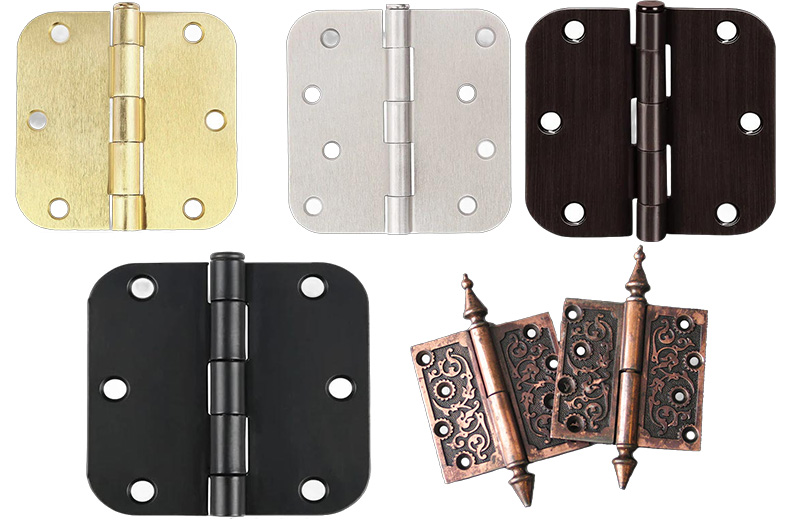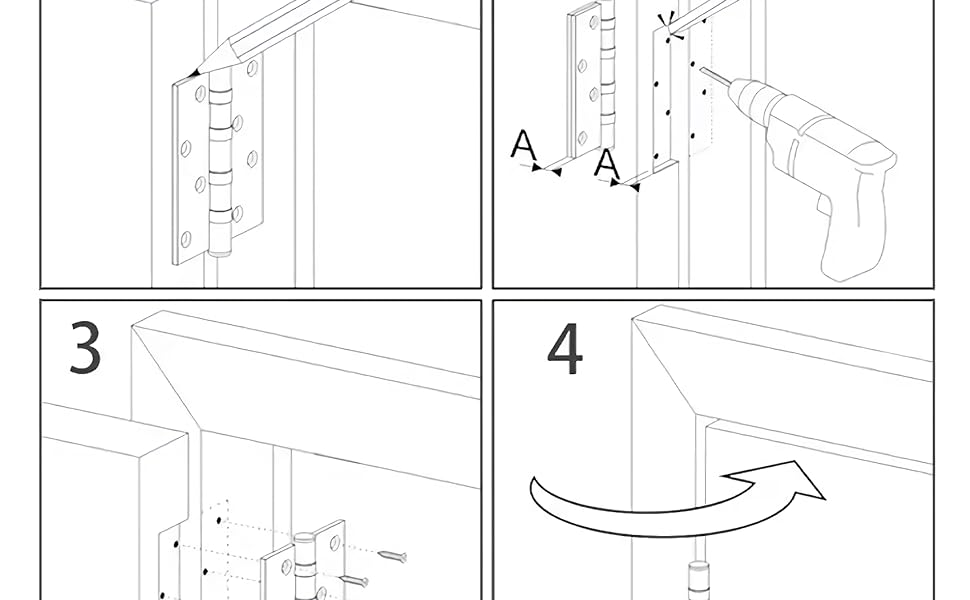
How to Choose the Right Hinges for Your Home
When it comes to home improvement projects, choosing the right hinges might seem like a small detail, but it’s actually a critical decision that can impact the functionality, safety, and aesthetics of your doors, cabinets, and furniture. Hinges are the unsung heroes that make things work smoothly. This comprehensive guide will help you understand the different types of hinges, their uses, and how to select the perfect ones for your home.
Understanding Hinges: The Basics

Hinges are mechanical bearings that connect two solid objects, typically allowing only a limited angle of rotation between them. They are crucial in providing the necessary pivot point for doors, gates, cabinets, and more. Here are the key components of a hinge:
Leaf: The flat, typically rectangular parts that are screwed to the surfaces being joined.
Knuckle: The cylindrical part where the leaves are joined, often containing a pin.
Pin: A rod that runs through the knuckle, holding the leaves together and allowing them to pivot.
Types of Hinges

1. Butt Hinges
These are the most common type of hinges used in homes. They are typically used for doors and consist of two rectangular leaves joined by a central pin. Butt hinges come in several varieties, including plain, ball-bearing, and spring-loaded.
Best Uses: Interior and exterior doors.
2. Concealed Hinges
Also known as European hinges, these are commonly used in modern cabinets. Concealed hinges are hidden when the door is closed, offering a clean and minimalist look.
Best Uses: Kitchen cabinets, bathroom cabinets, and other furniture with doors.
3. Pivot Hinges
Pivot hinges are typically used for heavy or high-traffic doors. They are mounted at the top and bottom of the door, allowing it to pivot rather than swing on side hinges.
Best Uses: Large doors, entryways, and custom architectural applications.
4. Continuous Hinges (Piano Hinges)
These long hinges run the full length of the door or lid, providing extra stability and support. They are ideal for applications where continuous support is needed.
Best Uses: Piano lids, heavy doors, and storage chests.
5. Strap Hinges
Strap hinges have long leaves, providing a strong and decorative option for gates, barn doors, and sheds. They are available in various styles, including traditional and decorative.
Best Uses: Gates, barn doors, and outdoor applications.
6. Spring Hinges
These self-closing hinges are often used for doors that need to close automatically. They are commonly used in public buildings and residential applications where self-closing is required.
Best Uses: Doors in public buildings, residential kitchens, and other self-closing door applications.
7. Barrel Hinges
Barrel hinges are used for applications where a hinge needs to be hidden, such as with doors that are flush with the surface they are mounted on.
Best Uses: Cabinets, furniture, and hidden doors.
Materials and Finishes

Materials
1. Brass
Brass is a popular choice for hinges due to its resistance to corrosion and its classic, elegant appearance. Brass hinges are durable and can withstand regular use without tarnishing or losing their shine. This material is particularly favored for its aesthetic qualities, making it a great choice for decorative applications where the hinge’s appearance is just as important as its function.
Best Uses: Interior doors, cabinets, and decorative furniture.
2. Stainless Steel
Stainless steel hinges are known for their strength and high resistance to rust and corrosion, making them suitable for both indoor and outdoor applications. They are ideal for environments exposed to moisture or humidity, such as bathrooms and kitchens, as they maintain their integrity and appearance over time.
Best Uses: Exterior doors, high-humidity areas like bathrooms, and kitchens.
3. Bronze
Bronze hinges are strong and have a unique look that evolves over time. They develop a natural patina, which can enhance their aesthetic appeal, especially in rustic or vintage settings. Bronze is also resistant to corrosion, making it a durable choice for both interior and exterior use.
Best Uses: Exterior applications, rustic or vintage decor.
4. Iron
Iron hinges are robust and suitable for heavy-duty applications. While they are strong, they require proper coating or maintenance to prevent rust. Iron hinges add a traditional and sturdy look, often used in settings that demand a strong and industrial appearance.
Best Uses: Gates, barn doors, and industrial settings.
5. Nickel
Nickel hinges offer a sleek, modern appearance and are resistant to corrosion. Their smooth finish and contemporary look make them ideal for modern interior designs. Nickel-plated hinges are durable and maintain their aesthetic appeal over time.
Best Uses: Modern interior doors, cabinets, and furniture.
Finishes
The finish of a hinge not only affects its appearance but also its durability and resistance to wear. Here are some common finishes:
1. Polished
A polished finish gives hinges a shiny, reflective surface. This finish is often used for decorative purposes, adding a touch of elegance and sophistication to doors and furniture. Polished finishes are available in various materials, including brass and stainless steel.
Best Uses: Decorative furniture, high-end interiors.
2. Satin
A satin finish offers a smooth, matte look that is less reflective than polished finishes. Satin finishes are modern and stylish, providing a clean and understated look that blends well with contemporary designs. They are available in materials like nickel and stainless steel.
Best Uses: Modern interiors, kitchen cabinets, and bathroom fixtures.
3. Antique
Antique finishes give hinges a weathered, aged look that adds character and charm to rustic and vintage designs. This finish is typically applied to materials like brass and bronze to enhance their natural patina and create a timeless appearance.
Best Uses: Rustic decor, vintage furniture, and historical restorations.
4. Oil-Rubbed
Oil-rubbed finishes provide a dark, rich look with a slightly oily feel. This finish is often used on bronze hinges and gives a unique, handcrafted appearance. It adds warmth and depth to any design, particularly in traditional and rustic settings.
Best Uses: Traditional interiors, rustic furniture, and exterior doors.
5. Black
Black finishes are sleek and modern, offering a bold and striking look. They are highly versatile and can complement a wide range of styles, from industrial to contemporary. Black finishes are typically applied to iron and steel hinges.
Best Uses: Modern and industrial designs, exterior gates, and furniture.
Choosing the Right Hinge for Your Application
1. Consider the Weight and Size of the Door
The weight and size of the door or lid you’re working with will largely determine the type of hinge you need. Heavy doors, for example, will require stronger hinges like butt hinges with ball bearings or continuous hinges.
2. Determine the Degree of Opening
Different hinges allow for varying degrees of opening. Concealed hinges, for example, can range from 90 to 180 degrees. Assess how far you need your door to open and select the appropriate hinge to meet that requirement.
3. Aesthetics
The look of the hinge can also play a crucial role in your decision. If you want the hinge to be invisible, concealed hinges are the way to go. For a rustic or decorative look, strap hinges or antique brass hinges may be ideal.
4. Environmental Factors
Consider where the hinge will be used. For exterior applications or areas with high humidity, opt for corrosion-resistant materials like stainless steel or brass.
5. Functionality
Think about how the hinge will function in everyday use. If you need a door to close automatically, spring hinges or self-closing concealed hinges are excellent choices.
Popular Hinge Brands and Products
1. Design House
Design House offers a range of high-quality hardware products, including durable and stylish door hinges. Their products are known for their reliability and aesthetic appeal.
2. Amazon Basics
Amazon Basics provides affordable and reliable hinges for various applications. Their range includes standard butt hinges and concealed hinges, perfect for DIY projects.
3. Blum
Blum is renowned for its innovative and high-quality concealed hinges, particularly for cabinets. Their products offer smooth operation and long-lasting performance.
4. Ravinte
Ravinte specializes in modern cabinet hardware, including soft-closing concealed hinges that are easy to install and adjust.
5. Antrader
Antrader offers a variety of hinges, including decorative and functional options. Their products are known for their affordability and quality.
6. National Hardware
National Hardware has been a trusted name in the hardware industry for decades. They offer a wide range of hinges, including heavy-duty options for gates and doors.
7. DecoBasics
DecoBasics focuses on cabinet hardware, offering high-quality concealed hinges that provide smooth and silent operation.
8. HOME MASTER HARDWARE
HOME MASTER HARDWARE offers a range of hinges for both residential and commercial applications. Their products are durable and reliable.
9. Richelieu
Richelieu is known for its innovative and stylish hardware solutions. Their range of hinges includes both concealed and decorative options.
10. TDCHINGES
TDCHINGES provides a variety of hinges for different applications, known for their durability and affordability.
11. UNIQANTIQ HARDWARE SUPPLY
UNIQANTIQ HARDWARE SUPPLY offers a range of antique and vintage-style hinges, perfect for restoration projects and period homes.
Installation Tips

1. Gather the Right Tools
Ensure you have all the necessary tools, including a screwdriver, drill, measuring tape, and level. Having the right tools will make the installation process smoother and more accurate.
2. Mark the Position
Use a pencil to mark the exact position where the hinges will be installed. Measure carefully to ensure that the hinges are aligned correctly.
3. Pre-Drill Holes
Pre-drilling holes for the screws can prevent the wood from splitting and make it easier to install the hinges.
4. Attach the Hinges
Start by attaching the hinges to the door first. Once they are securely in place, attach the door to the frame. Use a level to ensure that the door is straight.
5. Adjust as Needed
After installing the hinges, test the door to ensure it opens and closes smoothly. If necessary, make adjustments to the hinge placement or screws to achieve the perfect fit.
Maintenance Tips
1. Regular Cleaning
Clean your hinges regularly to prevent dirt and grime buildup. Use a damp cloth to wipe them down and avoid using harsh chemicals that could damage the finish.
2. Lubrication
Lubricate the hinges periodically to ensure smooth operation. Use a light machine oil or a silicone spray.
3. Check for Loose Screws
Over time, screws can become loose. Check your hinges regularly and tighten any loose screws to maintain their functionality.
4. Inspect for Wear and Tear
Look for signs of wear and tear, such as rust or bending. Replace hinges that show significant damage to ensure safety and proper function.
Conclusion
Choosing the right hinges for your home involves considering several factors, including the type of door or lid, the weight and size, the degree of opening, and the aesthetic appeal. By understanding the different types of hinges and their applications, you can make an informed decision that will enhance the functionality and appearance of your home.
Hinges may seem like a small detail, but they play a significant role in the overall functionality and aesthetics of your home. Whether you’re installing new cabinets, replacing an old door, or working on a custom project, selecting the right hinges is crucial for achieving the best results. With this guide, you’re well-equipped to choose the perfect hinges for your needs, ensuring smooth operation and a beautiful finish.



